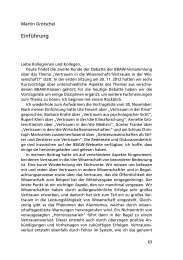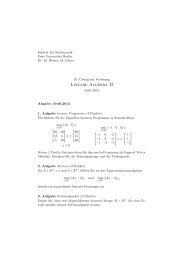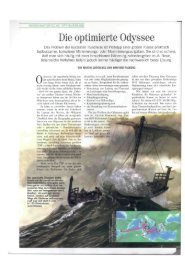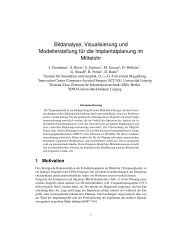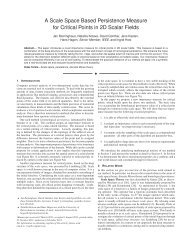3D Reconstruction of the Human Rib Cage from 2D Projection ... - ZIB
3D Reconstruction of the Human Rib Cage from 2D Projection ... - ZIB
3D Reconstruction of the Human Rib Cage from 2D Projection ... - ZIB
You also want an ePaper? Increase the reach of your titles
YUMPU automatically turns print PDFs into web optimized ePapers that Google loves.
5.4. Initialization<br />
Extended Distances<br />
The normal-extended distance dn is computed as follows: For a point xm with a<br />
certain normal orientation nm, <strong>the</strong> point xr with normal nr must be determined<br />
that minimizes <strong>the</strong> combined distance in Eq. (5.7). This xr is not necessarily <strong>the</strong><br />
point in Sr with <strong>the</strong> smallest Euclidean distance to xm. For this reason, <strong>the</strong> distance<br />
evaluation cannot be performed by calculating one distance map <strong>of</strong> Sr as previously<br />
described. Instead, a set <strong>of</strong> Euclidean distance maps Mi(i = 1, ..., k) is computed as<br />
follows:<br />
1. For all points in a reference silhouette and a model silhouette <strong>the</strong> normals are<br />
computed. A normal nm <strong>of</strong> a point xm ∈ Sm is given by <strong>the</strong> normalized image<br />
gradient <strong>of</strong> Im.<br />
2. All silhouette points are sorted into point sets pi according to <strong>the</strong>ir normal<br />
orientation. Therefore, a set <strong>of</strong> k normalized vectors<br />
ni = (cos(ϕi), sin(ϕi)) T<br />
(5.10)<br />
is built where ϕi = i · 2π/k is <strong>the</strong> orientation angle. A point with a normal nr<br />
is assigned to <strong>the</strong> set pi if arccos(ni · nr) ≤ π/k holds true.<br />
3. For each pi a Euclidean distance map Mi is calculated.<br />
The distance dn(xm, Sr) for a point xm is <strong>the</strong>n computed as follows: For each pi <strong>the</strong><br />
minimum Euclidean distance ei <strong>of</strong> xm to pi is retrieved <strong>from</strong> <strong>the</strong> distance map Mi.<br />
Then,<br />
dn(xm, Sr) = min((1<br />
+ we · ei)(2 − nm · ni)). (5.11)<br />
i<br />
For <strong>the</strong> area-extended distance da <strong>the</strong> area <strong>of</strong> a silhouette is given by <strong>the</strong> number<br />
<strong>of</strong> pixels enclosed by <strong>the</strong> silhouette contour.<br />
5.4 Initialization<br />
Applying a local optimization scheme as described in Sect. 4.5.1, introduces certain<br />
problems in determining a desired reconstruction. Since <strong>the</strong> objective function D<br />
exhibits local minima, it is likely to find local optimal solutions. Two strategies can<br />
help to alleviate this problem: One is to streng<strong>the</strong>n <strong>the</strong> robustness <strong>of</strong> <strong>the</strong> objective<br />
function – strategies for this (i.e., to find more meaningful point correspondences<br />
between silhouettes) have been proposed in Sect. 5.2. The o<strong>the</strong>r one is to determine<br />
an initialization near <strong>the</strong> desired solution.<br />
There are aspects, like <strong>the</strong> periodicity <strong>of</strong> similar structures as <strong>the</strong> ribs and <strong>the</strong><br />
symmetry <strong>of</strong> <strong>the</strong> rib cage, that contribute to <strong>the</strong> formation <strong>of</strong> local minima and,<br />
hence, should be avoided during initialization. Two approaches are introduced to<br />
establish an initial <strong>3D</strong> pose <strong>of</strong> <strong>the</strong> <strong>3D</strong> model prior to <strong>the</strong> reconstruction process.<br />
39



